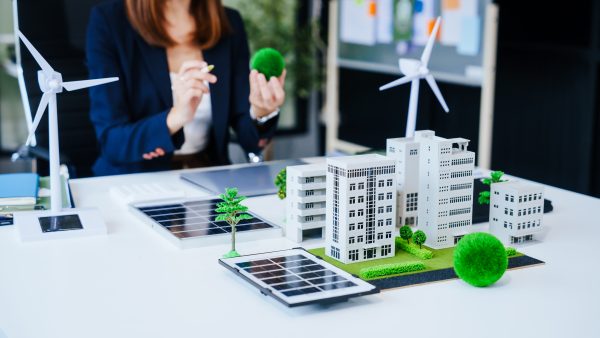In recent years, the construction industry has undergone a transformative shift toward sustainability. Green buildings—those designed with environmental responsibility and resource efficiency in mind—are becoming a critical focus for developers, architects, and engineers alike. What’s more, investing in green building upfront also enhances property value, with an increasing number of building owners experiencing a 10 percent or higher boost in asset value. While innovative materials and design strategies are key, data-driven construction practices are emerging as a powerful tool in the pursuit of greener buildings. By leveraging construction data, professionals can make informed decisions that reduce environmental impact, enhance energy efficiency, and create healthier living environments. This blog explores how construction data can play a pivotal role in making buildings greener and more sustainable.
The Rise of Standards for Greener Buildings
Before diving into the role of construction data, it’s important to understand the broader context of green building trends. Building certification programs such as LEED (Leadership in Energy and Environmental Design), BREEAM (Building Research Establishment Environmental Assessment Method), and WELL have set global standards for sustainable construction practices. These certifications promote energy efficiency, resource conservation, and the use of environmentally friendly materials. However, meeting these rigorous standards requires more than just good intentions. It also necessitates precise planning, execution, and, most importantly, data.
What Is Construction Data?
Construction data refers to the vast amounts of information collected throughout the lifecycle of a construction project. This includes everything from project planning and design to procurement, construction processes, and facility management. In recent years, advancements in technology such as Building Information Modeling (BIM), sensors, IoT devices, and cloud-based project management tools have revolutionized how data is collected and utilized on construction sites. When analyzed and applied effectively, this data can have a profound impact on building sustainability.
At BizForce, our team of highly skilled architects plays a pivotal role in leveraging this data to design sustainable, functional, and aesthetically pleasing buildings. By utilizing the latest tools and techniques, they ensure that every project not only meets the highest standards of design but also maximizes the potential for energy efficiency and resource optimization. Our architects are committed to helping construction firms achieve long-term sustainability goals through innovative and data-driven design approaches.
Greener Buildings With Construction Data

Data-Driven Design: Optimizing for Efficiency
One of the first opportunities to leverage construction data is during the design phase of a building. Tools like BIM allow architects and engineers to simulate the energy performance of a building before a single brick is laid. By analyzing factors such as sunlight exposure, wind patterns, and thermal performance, designers can create buildings that require less energy for heating, cooling, and lighting. Data-driven design helps optimize the building’s orientation, window placement, and insulation materials to minimize energy consumption while maximizing comfort.
For example, in large urban developments, construction data can be used to model how different building shapes and configurations impact the surrounding microclimate. This data can inform decisions about natural ventilation, daylighting, and green roofs. All of these contribute to the building’s overall sustainability.
Energy Efficiency: Monitoring and Reducing Consumption
Once construction begins, data continues to play a key role in creating greener buildings. Sensors and smart meters installed throughout the construction site can monitor energy use in real-time. This data provides insights into how energy is consumed during the construction process, highlighting opportunities to reduce waste. For instance, project managers can track the energy consumption of heavy machinery, lighting, and temporary HVAC systems. They can identify areas where renewable energy sources such as solar power or energy-efficient equipment can be deployed.
Beyond construction, data helps ensure that green building practices are maintained long after the building is completed. Smart building systems equipped with IoT sensors can monitor a building’s energy use and environmental conditions in real-time. This data enables facility managers to adjust HVAC systems, lighting, and other building operations to optimize energy efficiency. By continuously monitoring and analyzing energy consumption, buildings can significantly reduce their carbon footprint over time.
Material Selection: Reducing Embodied Carbon
Another critical aspect of greener construction is the selection of materials. Traditional building materials such as concrete and steel are notorious for their high levels of embodied carbon. These carbon emissions are associated with producing, transporting, and assembling these materials. Construction data can be used to evaluate the environmental impact of different materials. These data help project teams select low-carbon alternatives.
Databases that track the environmental performance of building materials, such as Environmental Product Declarations (EPDs), provide valuable information about the carbon footprint of various materials. By analyzing data from these databases, architects and builders can make informed choices about materials. Consequently, they can minimize environmental harm. Additionally, construction data allows project managers to track material sourcing and procurement. This data helps ensure that sustainable materials are used throughout the construction process to achieve greener buildings.
Waste Reduction: Data for Efficient Construction Practices
Construction waste is a major contributor to environmental degradation. For instance, millions of tons of waste are produced by construction and demolition activities each year. Fortunately, data-driven strategies can significantly reduce the amount of waste generated on construction sites.
One way to reduce waste is through the use of prefabrication and modular construction techniques. These rely on precise data to manufacture building components off-site. By producing components in controlled factory environments, waste is minimized, and materials are used more efficiently. On-site, project managers can use data to track material quantities and usage, preventing over-ordering and reducing the likelihood of materials being discarded.
Additionally, data can be used to plan and optimize logistics. Materials will arrive on-site at the right time and in the right quantities. This reduces the risk of material damage, spoilage, and waste due to improper storage or handling.
Water Management: Data for Sustainable Systems
Water conservation is another critical component of green building design. Construction data can be used to develop sustainable water management systems that reduce consumption and minimize waste. For example, data from weather sensors and smart irrigation systems can optimize water use in landscaping. Therefore, plants can receive the right amount of water based on real-time weather conditions.
Inside greener buildings, data can help monitor and manage water usage through smart plumbing systems. These systems detect leaks, track water consumption, and optimize water pressure. Additionally, they provide valuable insights that help reduce water waste and promote the efficient use of this precious resource.
Life Cycle Assessment: Data Beyond Construction
Data plays a crucial role in assessing the long-term sustainability of greener buildings throughout their lifecycle. Life Cycle Assessment (LCA) tools allow architects and engineers to evaluate the environmental impact of a building from cradle to grave—taking into account factors such as material extraction, energy use, maintenance, and eventual demolition.
By using construction data to conduct LCAs, project teams can identify areas where sustainability can be improved over the building’s lifespan. For example, data from maintenance logs can reveal which systems or materials require frequent replacement, prompting the use of more durable, sustainable alternatives in future projects.
Conclusion: Building a Greener Future with Data

The construction industry is at a turning point, and data is proving to be one of the most powerful tools in the journey toward greener buildings. By harnessing the power of construction data, architects, engineers, and builders can make informed decisions that lead to more energy-efficient, resource-conscious, and environmentally friendly buildings. From design and material selection to energy monitoring and waste reduction, data enables a level of precision and optimization that is critical for creating a sustainable future.
As technology continues to evolve, the role of data in construction will only grow more significant. By embracing data-driven practices today, the construction industry can build the green buildings of tomorrow. It can reduce its environmental impact while creating healthier, more resilient spaces for all.
Partner with BizForce today and let our talented architects help you transform data into sustainable design solutions. As leaders in architecture staffing, we provide firms with remote architects who are experts in leveraging cutting-edge technology to drive efficiency, sustainability, and innovation in every project. Whether you’re looking to optimize resource use, reduce environmental impact, or design buildings that stand the test of time, BizForce has the team to make it happen. Join us in building a greener future—contact us now to discover how we can elevate your next project.
